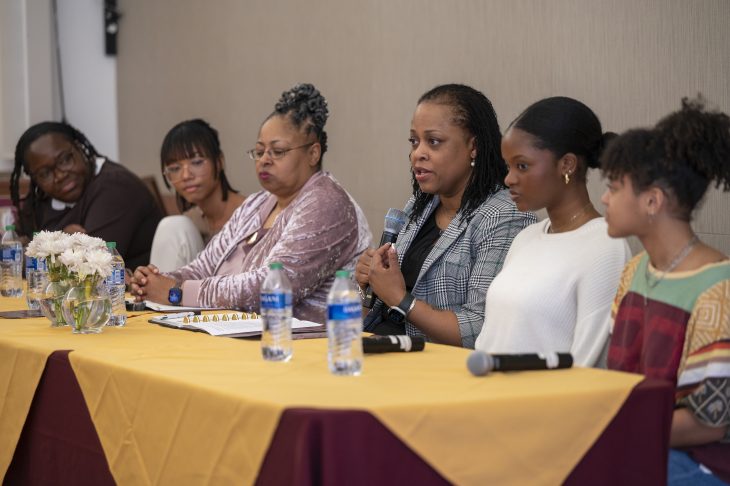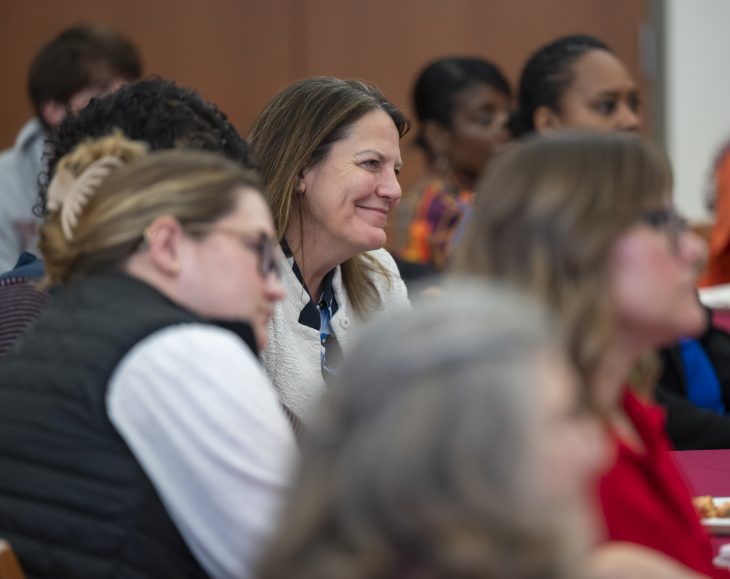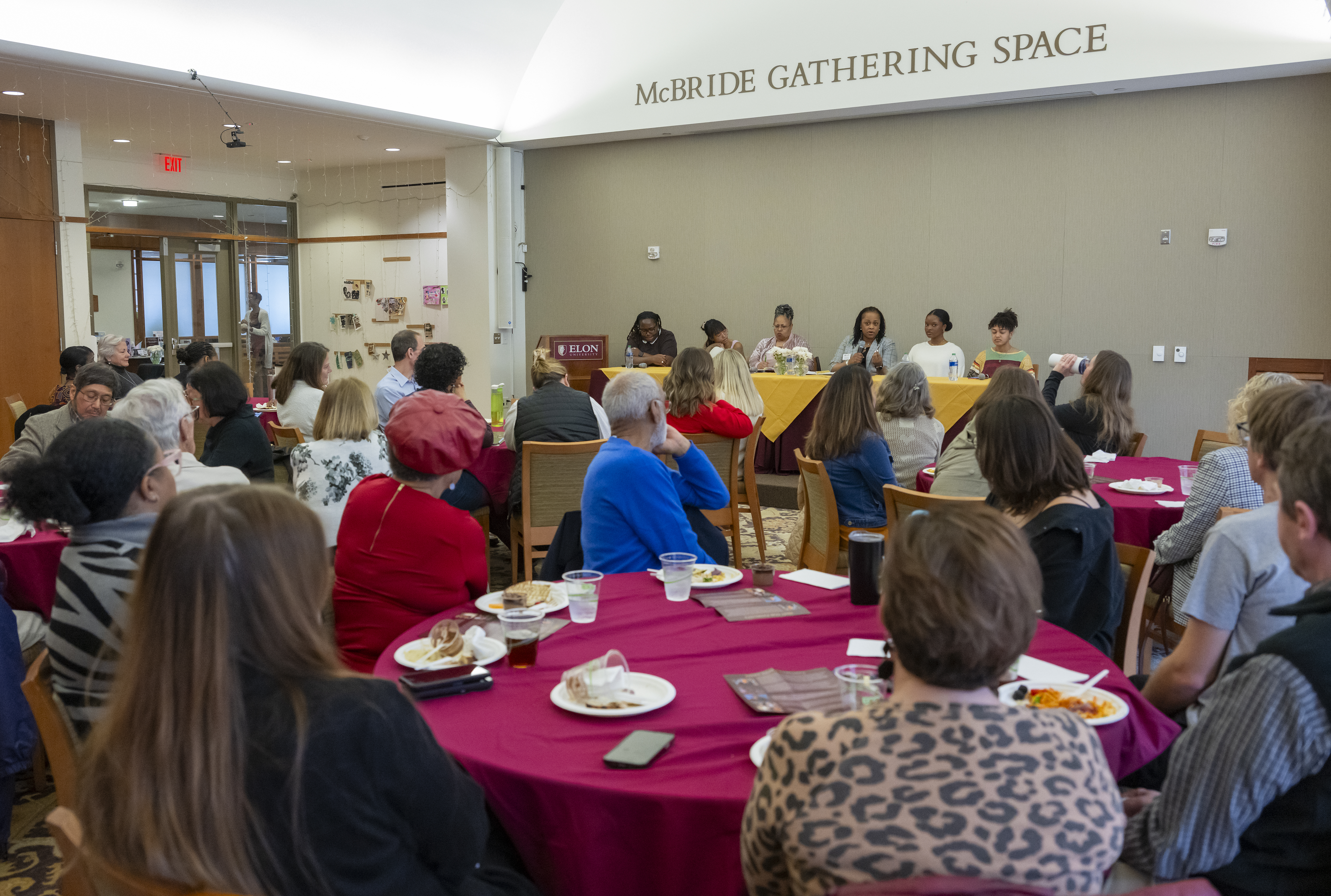The Truitt Center for Religious and Spiritual Life at Elon hosted its annual wInterfaith event on Feb. 28 with the theme, “Intersections of Race and Religion,” with a panel discussion about religious, spiritual and ethical traditions.
wInterfaith is an opportunity for the university community and the Elon community to engage with one another around different expressions of religion and spirituality with the theme this year of “Intersections of Race and Religion.”
On Wednesday, Feb. 28, members of the university community came together in the McBride Gathering Space in the Numen Lumen Pavilion for this year’s wInterfaith event, a midday panel discussion that offered insights from a broad range of perspectives and fostered conversation.
The event began with an introduction of the panelists by the Rev. Kirstin Boswell, university chaplain and dean of multifaith engagement. The panel Included:
- Sheila Otieno, assistant professor of religious studies and Distinguished Emerging Scholar in Religious Studies, who teaches religion and religious ethics, focusing on African and African American religious traditions.
- The Rev. Donna Vanhook ’07, Alamance Soil & Water Conservation District Supervisor and associate pastor at Union Chapel UCC. Vanhook is the first Black woman to serve as Soil and Water Conservation District Supervisor.
- Jasper Serenity Myers ’24, a scholar of ancient Mediterranean forms of worship and Japanese Buddhist traditions.
- Kayla Swenson ’25 holds a position on Hillel Executive Board as the CO Shabbat chair and mentors in the Elon SMART program.
- Fatmata Bah ’25 who is vice president of the Elon Muslim Society and is very passionate about fostering interfaith dialogue.

The discussion focused on how a person’s religious faith and their background in that faith can be empowering, with each panelist offering perspectives from their own faiths. Much of the discussion centered around the sense of identity and how faith and background contribute to that identity.
To start the discussion, each of the panelists was asked if it was OK to be referred to as a Black woman as one of the identities that they hold in common. “You step into a room and you’re stepping in this body and in all of those ways and forms, that manifests itself,” Boswell said.
Vanhook noted that the dialogue within her church promotes the “strong Black woman” myth, which can place a burden upon many women. That myth perpetuates the idea that because they are Black women, they should automatically be strong enough to handle anything. “It’s mythical and paradoxical, which means that in churches, in my faith tradition, you are taught that you have to be strong,” Vanhook said. “Many times we find ourselves in a position where we’re doing too much and not really doing enough for ourselves.”
Otieno explained that one person can have a wide variety of identities that can be molded by a person’s background and upbringing along with their various roles. “I am a teacher, I am a scholar, I am a researcher, but I’m also an Auntie, I am also a sister and I am also a daughter,” Otieno said.
Vanhook said that being a Black woman is just one identity among many for her. “At some point, I have to separate myself,” Vanhook said. “Understanding that I am somebody empowers me again to continue my journey into doing something God has called me to do.”
Identities can be a big part of someone’s life, and it can be tricky to navigate when you have multiple identities that can either clash with one another or work together, Bah said. “There are misconceptions about all my identities or at least when I enter a room,” Bah said. “You may not know that I’m Muslim when you meet me, but you will see that I’m Black.”
Identities can also shape a way in how someone looks at a group and not a person, Swenson noted. “Not one person speaks for everybody,” said Swenson.
Another part of learning about identities is being open to listening and taking in information, she said. “Just because you have one conversation with somebody doesn’t mean that you can have a conversation with someone else that holds the same identity and it’s going to look the same,” Swenson said.

Having multiple identities can shape a person and how they look at the world or how they navigate themselves, Bah said. “If you’re cherry picking that kind of creates another issue,” Bah said. “I think education in general is important to address those misconceptions, interacting with people from different states and people from different religions.”
Myers shared that she was raised Roman Catholic, and that her identity has been formed by more than just what she heard in church. What she has learned through her own journey has contributed to how she sees herself. “I had to reshape my own opinion, my own self-conception, my own identity and that was an empowering process in and of itself, because I had a new understanding of myself,” Myers said.
Boswell pulled together many of the observations that the panelists offered by noting that identities can bring with them a weight of expectation. “What was reinforced across the board when looking at Black women, of varying faith identities and other types of identities, we’re all carrying this load, this pressure to be perfect, to be the example,” Boswell said.



